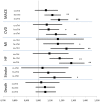Comparison of three troponins as predictors of future cardiovascular events--prospective results from the FINRISK and BiomaCaRE studies
- PMID: 24594734
- PMCID: PMC3942371
- DOI: 10.1371/journal.pone.0090063
Comparison of three troponins as predictors of future cardiovascular events--prospective results from the FINRISK and BiomaCaRE studies
Abstract
Importance and objective: Besides their role in diagnosis of acute myocardial infarction (MI), troponins may be powerful biomarkers for risk stratification in the general population. The objective of our study was to compare the performance of three troponin assays in cardiovascular disease (CVD) risk prediction in a population-based cohort without a history of CVD events.
Design, setting and participants: Troponin I concentrations were measured using a contemporary-sensitivity, high-sensitivity, and super-sensitivity assay in 7,899 participants of the general-population based FINRISK 1997 cohort. We used Cox proportional hazards regression to determine relative risks, followed by measures of discrimination and reclassification using 10-fold cross-validation to control for over-optimism.
Main outcome: As outcome measures we used CVD, MI, ischemic stroke, heart failure (HF), and major adverse cardiac events (MACE). During the follow-up of 14 years 1,074 incident MACE were observed.
Results: Values above the lower limit of detection were observed in 26.4%, 81.5% and 93.9% for the contemporary-sensitivity, high-sensitivity and super-sensitivity assay, respectively. We observed significant associations of troponin concentrations with the risk of future CVD events and the results tended to become stronger with increasing assay sensitivity. For the super-sensitivity assay the multivariate adjusted hazard ratios (per one standard deviation increase) for different outcomes were: MI 1.24 [95% CI 1.11-1.39], stroke 1.14 [1.01-1.28], CVD 1.15 [1.07-1.24], HF 1.28 [1.18-1.39], and MACE 1.18 [1.11-1.25]. In subjects with intermediate risk, we found an improvement of net reclassification for HF (10.2%, p<0.001), and MACE (5.1%, p<0.001).
Conclusion: Using a super-sensitivity assay, cardiac troponin was detectable in almost all healthy individuals. Its concentration improved risk prediction and reclassification for cardiovascular endpoints.
Conflict of interest statement
Figures


References
-
- Keller T, Zeller T, Ojeda F, Tzikas S, Lillpopp L, et al. (2011) Serial changes in highly sensitive troponin I assay and early diagnosis of myocardial infarction. JAMA 306: 2684–2693. - PubMed
-
- Keller T, Zeller T, Peetz D, Tzikas S, Roth A, et al. (2009) Sensitive troponin I assay in early diagnosis of acute myocardial infarction. N Engl J Med 361: 868–877. - PubMed
-
- Haaf P, Drexler B, Reichlin T, Twerenbold R, Reiter M, et al. (2012) High-sensitivity cardiac troponin in the distinction of acute myocardial infarction from acute cardiac noncoronary artery disease. Circulation 126: 31–40. - PubMed
-
- Graham I, Atar D, Borch-Johnsen K, Boysen G, Burell G, et al. (2007) European guidelines on cardiovascular disease prevention in clinical practice: executive summary. Fourth Joint Task Force of the European Society of Cardiology and other societies on cardiovascular disease prevention in clinical practice (constituted by representatives of nine societies and by invited experts). Eur J Cardiovasc Prev Rehabil 14 Suppl 2: E1–40. - PubMed
-
- Thygesen K, Mair J, Mueller C, Huber K, Weber M, et al. (2011) Recommendations for the use of natriuretic peptides in acute cardiac care: A position statement from the Study Group on Biomarkers in Cardiology of the ESC Working Group on Acute Cardiac Care. Eur Heart J - PubMed
Publication types
MeSH terms
Substances
LinkOut - more resources
Full Text Sources
Other Literature Sources
Medical
Research Materials
Miscellaneous

